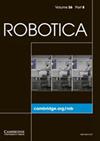基于六杆联动的步态康复机器人的定制刚度控制策略
IF 2.7
4区 计算机科学
Q3 ROBOTICS
引用次数: 0
摘要
基于联动机构的下肢康复机器人因其众多优势,最近在该领域引起了极大关注。之前提出的基于联动机构的步态康复机器人矫形器的控制是通过恒速控制实现的,没有考虑相互作用力。然而,这种方法可能会对中风患者造成伤害,因为每个人的残疾程度不同,而且当机器人施加过大的力时,可能会造成潜在的伤害。为了克服这一局限并改善康复过程,有必要识别人在行走过程中施加的力,并相应调整机器人的辅助力矩,以提供同步运动。因此,本研究提出了一种基于六杆联动步态康复机器人刚度控制策略的人类合作方法。所提出的方法可作为开发基于联动的下肢康复机器人矫形器的人类合作方法的坚实基础。该控制方法通过八名健康人体受试者进行了验证和测试。因此,可以在训练过程中利用该机制提供定制的机器人辅助,以满足中风患者的个性化需求,从而提高参与度和贡献度,改善治疗效果。本文章由计算机程序翻译,如有差异,请以英文原文为准。
Customized stiffness control strategy for a six-bar linkage-based gait rehabilitation robot
Lower limb rehabilitation robots based on linkage-based mechanisms have recently drawn significant attention in the field due to their numerous advantages. The control of previously proposed linkage-based gait rehabilitation robotic orthoses has been achieved using constant speed control without consideration for the interaction forces. However, such an approach can be harmful to people with stroke since the level of disability varies among individuals, and it may cause potential injuries when excessive force is applied by the robot. To overcome this limitation and improve the rehabilitation process, it is necessary to recognize the force exerted by the person during walking and adjust the robot’s assistive torque accordingly, to provide synchronized motion. Thus, in this work, a human-cooperative approach based on a stiffness control strategy for the six-bar linkage-based gait rehabilitation robot is presented. The proposed methodology can serve as a solid foundation for developing a human-cooperative approach for linkage-based lower limb rehabilitation robotic orthoses. The control was validated and tested with eight healthy human subjects. As a result, customized robotic assistance with this mechanism can be provided during training to meet the individual needs of stroke patients, which can lead to increased engagement and contribution, thus improving treatment outcomes.
求助全文
通过发布文献求助,成功后即可免费获取论文全文。
去求助
来源期刊

Robotica
工程技术-机器人学
CiteScore
4.50
自引率
22.20%
发文量
181
审稿时长
9.9 months
期刊介绍:
Robotica is a forum for the multidisciplinary subject of robotics and encourages developments, applications and research in this important field of automation and robotics with regard to industry, health, education and economic and social aspects of relevance. Coverage includes activities in hostile environments, applications in the service and manufacturing industries, biological robotics, dynamics and kinematics involved in robot design and uses, on-line robots, robot task planning, rehabilitation robotics, sensory perception, software in the widest sense, particularly in respect of programming languages and links with CAD/CAM systems, telerobotics and various other areas. In addition, interest is focused on various Artificial Intelligence topics of theoretical and practical interest.
 求助内容:
求助内容: 应助结果提醒方式:
应助结果提醒方式:


